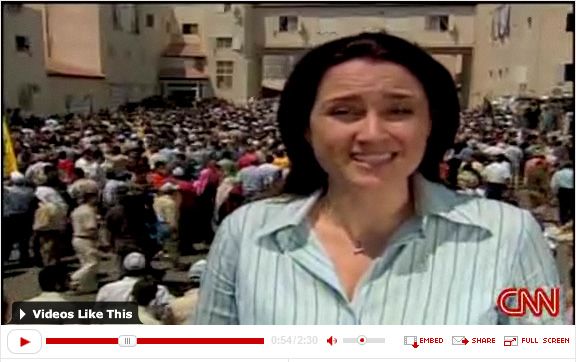HonestReporting has been tracking bias at CNN for many years. We named CNN a “runner-up” in our 2001 Dishonest Reporting award thanks to analysis showing that its coverage disproportionately relied far more on images and interviews with Palestinians than with Israelis. Since then, we have critiqued CNN several times. One example was CNN’s undue haste to air breaking news, when it accepted the Palestinian accusations related to the “Gaza Beach Massacre” only to issue a retraction later.
Last year, we named CNN senior correspondent Christiane Amanpour winner of our “2007 Dishonest Reporting” award for her series in which she drew parallels between Jewish and Islamic terrorists.
Against this background, we decided to see how CNN’s Middle East reporting stood up as a whole. Since CNN.com bases more and more of its coverage on video, we decided to analyze CNN video reports available online. Over the last 12 months, after viewing video segments from CNN correspondents as well as raw video footage hosted by CNN on its website, we found several disturbing patterns.
CNN: November 1, 2007-October 31, 2008 – Summary of Findings:
- Sixty-seven minutes of the combined video segments were spent airing images sympathetic to the situation of the Palestinians. Only a total of 31 minutes and forty-five seconds illustrated the Israeli side.
- Almost twice as many people interviewed (56) were critical of Israeli polices as opposed to those who were critical of Palestinian actions or defended Israel (30).
- Twenty-one out of thirty-one cases (67%) in which CNN hosted raw footage on its website reflected negatively on Israel.
I. Balance
We reviewed hundreds of video reports hosted on CNN’s website (all publicly available in CNN archives at CNN.com.) From these, we selected 53 reports in which the subject matter dealt with an aspect of the Israeli-Palestinian conflict. We excluded reports that focused on subject matter that was either not in dispute or not relevant. So, for example, a report about domestic Israeli politics was not included while reports on rocket attacks against Sderot or military strikes against Gaza were.
We then recorded the total time in the reports that featured images likely to draw sympathy for one side or the other. Sometimes the entire length of the report highlighted one side’s plight. Other times the report included images representing both sides. Our goal was to determine whether CNN was giving more time to footage favoring one side of the conflict over the other. We found that video footage favored the Palestinians over Israel by an almost two-to-one margin.
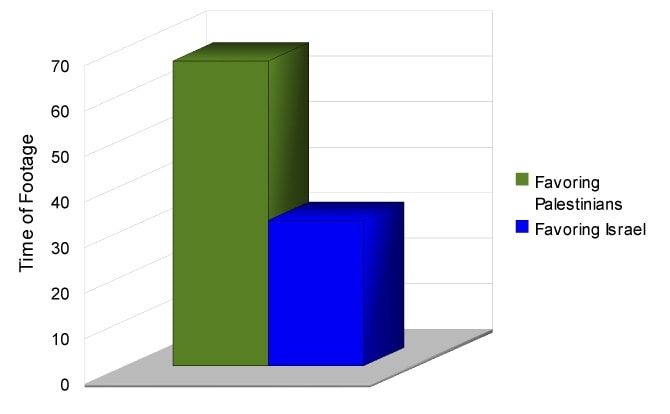 Example A: “Gaza City in the Dark”
Example A: “Gaza City in the Dark”
 Gaza City in the Dark is an extremely telling report. For the first half of the segment, correspondent Ben Wedeman reports on the blackout in Gaza City and how difficult it has made life for Gaza’s residents. Throughout the segment, we are shown multiple scenes of Gazans holding candles. However, when questioned by CNN anchor Adrian Finnigan, Wedeman admits:
Gaza City in the Dark is an extremely telling report. For the first half of the segment, correspondent Ben Wedeman reports on the blackout in Gaza City and how difficult it has made life for Gaza’s residents. Throughout the segment, we are shown multiple scenes of Gazans holding candles. However, when questioned by CNN anchor Adrian Finnigan, Wedeman admits:
“I think it does appear that there is a fair amount of manipulation of the power cuts by Hamas for publicity purposes. It is unclear what is behind these power cuts in Gaza.”
Yet Wedeman and others continue to report from Gaza about the Israeli blockade in the weeks after this report aired. Instead of acting on their suspicion and investigating and debunking the Palestinian claims, we simply see more reports of Israeli-imposed blackouts and candlelit anti-Israel protests.
Example B: “Palestinian Prisoners Released”
The story referenced above (click here to go to video) from August 26 reports on Israel’s release of almost 200 Palestinian security prisoners. The vast majority of the report shows a festive atmosphere in which freed prisoners are greeted as heroes. For two minutes and ten seconds, we see images that reflect the Palestinian perspective – joy for those released and a plea for those still jailed to also be freed.
Towards the end of the piece, a mere twenty seconds gives the Israeli perspective: Freed terrorists in the past have gone on to commit murder and other acts of terrorism. Some may claim that this segment is “balanced” since both perspectives are represented. But to focus on one side for more than seven times the amount devoted to the other side is anything but.
Example C: “Daily Suffering in Gaza”

In the above example (click here to go to video), CNN correspondent Ben Wedeman again details the daily suffering in Gaza. However, there is little context given for the reasons behind Israel’s partial blockade. There are no interviews with Israeli government officials explaining the raid or even a short clip of life in Sderot under rocket attack. A man identified as a “human rights activist” tells CNN the reason for the suffering: “You are punishing a nation in an unprecedented way for just one reason: because these people elected Hamas, that’s all.” With just a single reference to “fighting between Israel and the militants,” the entire four minutes and twenty-five seconds of this report detail Palestinian grievances.
II. Perspective
Besides time devoted to different views of the conflict, the choice of interview subjects for CNN broadcasts is also key. Whether the person being interviewed is a government official, a technical “expert”, or just a “man in the street,” that person’s opinions are broadcast around the world and can determine the balance of a news segment.
Sinc
e Israelis and Palestinians can be (and often are) critical of their own governments, we didn’t simply divide people by their ethnicity. Instead, we recorded how many individual interviews in the reports promoted critical views of Israeli actions versus those who were critical of Palestinian actions. We found that in the 86 interviews embedded in the video segments that we analyzed, almost twice as many were critical of Israel (56) than those critical of Palestinian actions (30).
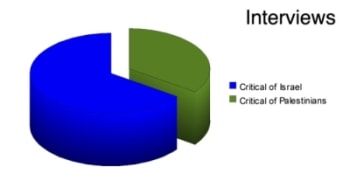 Example D: “Forced Turncoats?”
Example D: “Forced Turncoats?”
 The segment above (click here to go to video) examines the accusation that Israel demands that Palestinians seeking medical treatment within Israel act as informants. Two Palestinians are given time to make their personal claims followed by a woman representing a non-governmental organization. Against these three narratives, Israeli spokesperson Mark Regev is allotted a short time to rebut the accusations. But his defense is completely overwhelmed by the time spent with the Palestinian patients.
The segment above (click here to go to video) examines the accusation that Israel demands that Palestinians seeking medical treatment within Israel act as informants. Two Palestinians are given time to make their personal claims followed by a woman representing a non-governmental organization. Against these three narratives, Israeli spokesperson Mark Regev is allotted a short time to rebut the accusations. But his defense is completely overwhelmed by the time spent with the Palestinian patients.
Example E: “Gaza Students Desperate to Go”
 The video segment above (click here to go to video) details the struggles of a small number of Palestinian students refused permission to leave Gaza to study in the United States. Two Palestinian students tell their stories while an “expert” falsely claims that Israel controls all of Gaza borders. In fact, Israel today has no presence on Gaza’s border with Egypt. Yet the viewer would not know this from the report. Once again, Mark Regev voices Israel’s position but is immediately contradicted by the “expert’s” false statement.
The video segment above (click here to go to video) details the struggles of a small number of Palestinian students refused permission to leave Gaza to study in the United States. Two Palestinian students tell their stories while an “expert” falsely claims that Israel controls all of Gaza borders. In fact, Israel today has no presence on Gaza’s border with Egypt. Yet the viewer would not know this from the report. Once again, Mark Regev voices Israel’s position but is immediately contradicted by the “expert’s” false statement.
III. Raw Footage: Negative Impressions
A highly questionable CNN practice is to include raw video footage (often from the Associated Press) on its website mixed with narrated news reports. Middle East news is complicated enough to explain to viewers with the aid of a correspondent. Making sense of events by viewing very selective raw video footage is impossible. We found that in almost seventy percent of the videos we analyzed, actions shown without proper context reflect negatively on Israel.
While CNN is not responsible for content provided by outside news sources such as AP, CNN is responsible for vetting such material before posting it on its web site.
Example F: “More Violence In Gaza”
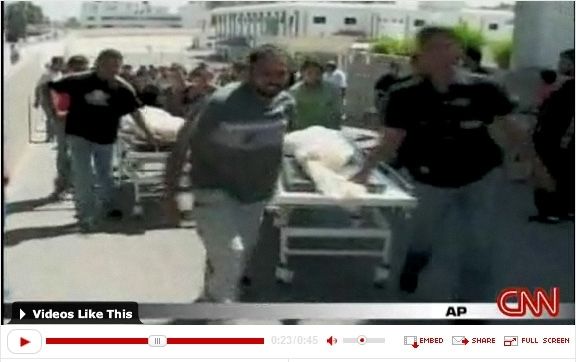 In the example above (click here to go to video), CNN hosts an AP video showing the aftermath of an Israeli airstrike on a car in Gaza. No reasons for the Israeli strike are given. In fact, in this particular strike, members of the Islamic Jihad terrorist group, responsible for firing rockets into the Israeli city of Sderot were killed. All we see are the smoldering remains of a car in Gaza surrounded by a crowd and a shot of bodies on stretchers. These videos are subsequently employed by those who accuse Israel of unprovoked aggression against civilians in Gaza.
In the example above (click here to go to video), CNN hosts an AP video showing the aftermath of an Israeli airstrike on a car in Gaza. No reasons for the Israeli strike are given. In fact, in this particular strike, members of the Islamic Jihad terrorist group, responsible for firing rockets into the Israeli city of Sderot were killed. All we see are the smoldering remains of a car in Gaza surrounded by a crowd and a shot of bodies on stretchers. These videos are subsequently employed by those who accuse Israel of unprovoked aggression against civilians in Gaza.
Example G: “West Bank Clashes”
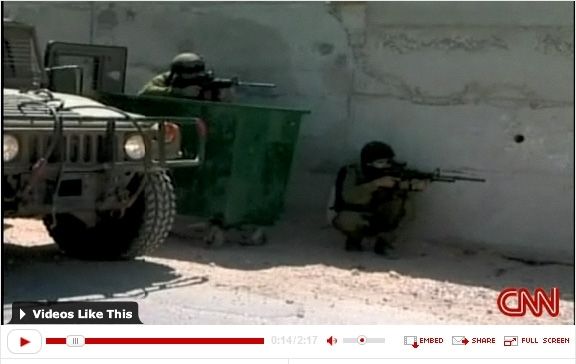 A number of AP videos are hosted on the CNN website under the same headline: “West Bank Clashes.” No matter the date, these videos are very similar, all showing heavily armed Israeli soldiers discharging their weapons and throwing tear gas grenades. They all also show people described by the captions as “protestors” waving flags, running from the soldiers, and occasionally throwing rocks. (Examples from 2008: October 3, August 2, July 9, and May 29).
A number of AP videos are hosted on the CNN website under the same headline: “West Bank Clashes.” No matter the date, these videos are very similar, all showing heavily armed Israeli soldiers discharging their weapons and throwing tear gas grenades. They all also show people described by the captions as “protestors” waving flags, running from the soldiers, and occasionally throwing rocks. (Examples from 2008: October 3, August 2, July 9, and May 29).
The viewer, however, has no way of knowing that these so-called “non-violent” Palestinian demonstrations are anything but. As we have documented, the goal of the protestors is often to use enough violence to provoke the Israeli soldiers into a response while the cameras are rolling. These raw footage clips portray Israel in a very negative light compared to the protestors.
Conclusions
To its credit, CNN has shown a past willingness to listen to criticism and make changes. Several years ago, when HonestReporting subscribers flooded CNN on a daily basis with angry letters demanding better coverage, the network made several specific policy changes in response to the accusations of bias. (Read the whole story here.) For a few years, Middle East coverage improved significantly.
Yet, as this report shows, anti-Israel bias has crept back into CNN’s coverage. That is why it is an appropriate time to demand that CNN take a comprehensive look at its Middle East reporting and set objective standards to make sure that its coverage is not tainted with bias. Specifically, CNN must:
- Ensure that reports provide appropriate balance in terms of images of the conflict and embedded interviews.
- Remove unedited raw video footage or provide proper context for that footage.
- Avoid excessive haste by taking time to ascertain exactly what is happening before broadcasting confusing footage.
- Provide more information in video headlines and captions.
HonestReporting subscribers should demand that CNN provide more objective and balanced coverage by going to the CNN contact page
>. We will continue to monitor CNN in our regular weekly communiques and for special reports such as this. If you would be interested in underwriting a long term media analysis, please e-mail us here.

